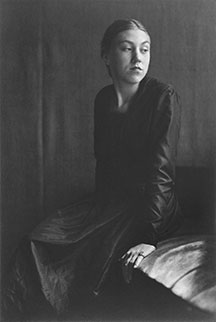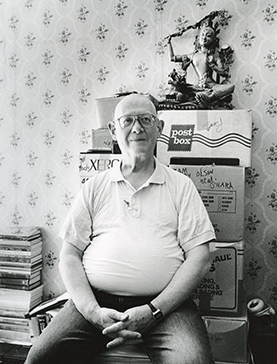
IRIS login | Reed College home Volume 95, No. 2: June 2016
Letters

Starved for an Answer
Congratulations to the three Reedies who won a prize for their research on the “hunger hormone” ghrelin. Upon reading the story in Reed (March 2016) I was left with a powerful appetite for an answer to the question: how does one measure a rat’s remorse?
Editor's Note: Sometimes a rat is just a rat.

Sculptor of the Surreal...
It was with great interest and enthusiasm that I read John Sheehy’s article on Xenia Kashevaroff Cage ’35. In my capacity as media specialist at Cornish College of the Arts in Seattle, I have just published what could almost be a companion piece on Cornish alumna Bonnie Bird, dancer with Martha Graham and director of dance at Cornish from 1937 to 1940. Bird and Xenia share many important connections.

Photo by Edward Weston, 1931
During her years at Cornish, Bird was Merce Cunningham and Syvilla Fort’s teacher and it was she who hired John Cage as accompanist and composer for the department. She ran the program on the company model, and Xenia, who came to Cornish with Cage, designed sets for the group. In 1940, school founder Nellie Cornish was forced out, and Bird, Cage, and Xenia soon followed her out the door. Cage’s first percussion orchestra was formed at Cornish. This work would lead to his groundbreaking work for prepared piano, “Bacchanale,” in 1939, which he composed for Syvilla Fort’s senior project.
Bird’s husband, Dr. Ralph Gundlach, a UW professor, was on an advisory panel for Reed in the ’40s. His daughter, Joan, entered Reed during that time, probably in 1947. In 1948, Bird taught the first of three intensive summer dance courses at Reed that included full productions, some reworkings of her Cornish pieces. Her students at Reed included multifaceted Remy Charlip and actress Hope Lange.
Gundlach and Bird were closely connected to a number of leftist causes, and he was one of three tenured professors fired by UW in 1949 as the result of pressure from the red-baiting Canwell Commission.
Some Reedies of my vintage may remember seeing Cage play prepared piano in the commons. Probably my first or second year, 1972–4. He returned the next year and performed again at the then Museum School near PSU.

... and Whacker of Flowerpots
I wanted to express my thanks for the March edition of Reed. I have to confess that I’m not a constant Reeder, but when I opened this last month’s issue, I saw my favorite photo of Xenia Kashevaroff Cage ’35. The next pleasure was John Sheehy’s article.
Xenia surely deserves far more than the two pages Reed gave her, and Sheehy’s fine note—remarkably comprehensive given its length—was almost certainly edited with some severity. (Yes!—Ed.) Still, it’s surprising how little is known about this fascinating woman who, sadly, never rebounded from the breakup with Cage. She likely had been a difficult partner in the last years of their marriage, and Cage never hid from Xenia his attraction to men. Cage, Kashevaroff, and a young Merce Cunningham had all known each other in Seattle, and Xenia surely found Cunningham every bit as attractive as did Cage.
From faraway England, Susan Gilbert is assembling a much-needed biography, and this hopefully will position Xenia’s life even more clearly within the NY art scene. She was a long-time friend of the notoriously solitary Joseph Cornell, and worked closely with Duchamp on his famous La-Boîte-en-Valise series. Sheehy identifies her father’s Aleutian Creole-Russian heritage, but space likely prohibited mention of her mother’s Tlingit identity (and her remarkable father’s fluency in the Tlingit language, as well as Russian and English). Father Andrew founded the Alaska State Museum, loaned Native artifacts to a Paris exhibition that fueled the surrealist movement, and vociferously opposed Canadian efforts to ban the potlatch and winter dance ceremonies which formed the social and economic basis of an extraordinarily rich coastal culture. His was nearly the only religious voice raised in opposition to Canadian cultural genocide. Potlatch raids and arrests “liberated” First Nations’ artifacts so that they could be sold to museums and private collectors. In recent years some have been repatriated.
Xenia was thought exotic by her admirers, and portrayed in that way in Weston’s photos (six of her in the buff Xenia kept throughout her life). Peggy Guggenheim included her in the 1943 Exhibition by 31 Women, an exhibition whose other contributors included Frida Kahlo, Djuna Barnes, Hedda Sterne, Dorothea Tanning, and Louise Nevelson. Xenia was an artist, if today a largely forgotten one. But Xenia was also a Native American. Just as African art was a key influence on cubism, so was North Coast Indian art on surrealism. As one surrealist effused following the Parisian exhibition of Father Kashevaroff’s artifacts, “We breathe in Alaska, we dream Tlingit, we make love in Haida totem poles.” And there she was in New York, a Tlingit from Alaska, the real thing.

Laurie, Laurie, Hallelujah
Last fall, without fanfare, Class Notes Editor Laurie Lindquist retired after 29 years at Reed. But a beautiful fanfare would be richly deserved (as, no doubt, is her retirement). Because for many years she has been the heart and soul of the magazine’s class notes and especially the pieces that are now called In Memoriam, many years of which can now be found online. For those of us who have lost someone from Reed and had something we needed to say about them, Laurie gave us the place to say it. Much of the time she herself found the people and the resources (the Oral History Project for one) to make a true memorial to the classmates we remember—and also gave us a sense of the essence and value of people we’d never heard of, but who were part of our community, and this was our chance to meet them.
It was a gift that brought a lot of healing with it, and we can only be grateful for her service, and wish her the very best in whatever she puts her mind—and her extraordinary heart—to next.
Editor's Note: Hear, Hear! Laurie’s contributions to the magazine are legion (and legendary), and she has probably written and edited more words about Reed and Reed alumni than anyone alive. We are heartbroken to see her go but happy that she will now have time to pursue her various pursuits.

Loosen Up. Festoon!
This is the third time that I’ve written you a letter, this one sparked by having just now read John Sheehy’s nicely written and sober review of the new biography of Philip Whalen ’51 by David Schneider ’73, Crowded by Beauty. I would like to offer a more enthusiastic perspective.
The first of my three letters was written in 1972 when I was living at the Tassajara Zen monastery not long after graduating from Reed in “philosophy & religion.” For identification purposes, should one of my surviving comrades read this, I was “Ricky Levine” at Reed. Then known as “Rick” for four decades, now “Rickety.” (Recall the riddle of the sphinx?)

Philip Whalen ’51, San Francisco, 1988
Photo by Rob Lee
On a cold gray rainy mountain day in the winter of ’72 I received the Reed alumni news at Tassajara and was reflecting with my dharma brothers Phil Whalen and Patrick McMahon ’69 at the news of illustrious attainments. Everyone was enjoying great success in business, enrollment in prestigious universities, advanced degrees, impressive titles. With Phil’s encouragement I sent you our news: “Rick Levine and Patrick McMahon are sorting rocks as to small, middling, and large for an esoteric fringe group in the California wilderness.”
Despite suffering a lifelong “poetical indisposition,” Phil had an air of bemused dignity and quiet authority. In the “tea area” there was a peg-board where everyone kept their coffee/tea mug. A strip of masking tape served as label to identify the owner. Mine said “Rick,” Patrick’s said “Pat.” Phil’s said “Philip G. Whalen, B.A.” (I for one read an allusion to Joyce’s Ulysses here). Phil lived, as we all do, in many worlds. Literature was prominent among them, and resonant echoes of language, spoken and literary, resounded in his daily life and society. As Schneider chronicles, Phil was awarded the BA in literature from Reed College in 1951, not without considerable travail.
My second letter was composed some few years later. It was a protest against the disestablishment of calligraphy at Reed as a central, accredited, and emblematic course offering. I, like Phil before me, was a student (disciple even) and advisee of Prof. Lloyd J. Reynolds [English and art, 1929-69], from whom I learned to read books, one after another, and several at the same time. I learned the history of the alphabet, the Perennial Philosophy, and how to cut & operate a pen using a reed and a pen-knife. (I had the good fortune to study under Father Robert Palladino as well.) A friend showed to the poet Robert Creeley a letter that I had written her. He glanced and commented, so she told me, “oh yeah, Reed-writing”. In more ways than one.
And now this, my third letter. Crowded By Beauty, David Schneider’s biography of Philip, is brilliantly written, and a lifeline he’s tossed to save whoever’s around to catch it—a rope braided with Phil’s personal and poetry histories; the history of “the Beats,” both East Coast and especially their West Coast iterations; with Friendship and friendships; with the Reed Poets’ lineage and their Pacific Northwest background; with Professor Lloyd Reynolds’s influence and the Portland revival of calligraphy & handwriting; with Buddhism; with Buddhism in America; with the authoritative self-Secret Oral Teachings of Buddhism; with how to read a poem (and the latter not just for slow learners and the dim-witted, but a primer for guys just like me, for me!).
David has the deep, credible expertise to illuminate all these strands, not least because he attended Reed, knows the ground where Phil’s life as a poet began, and is uniquely situated to have produced this stunning book. He is an accomplished calligrapher himself, in both Roman alphabets and Siddham script, an acharya (teacher) in the Shambhala lineage of Tibetan Buddhism, and a shuso-level priest (“Head Monk”) in Zen Buddhism. He is the author of a previous outstanding biography of the flamboyant cross-dressing Zen adept named Issan Dorsey, titled Street Zen, in which Issan’s wild early life is lovingly depicted as well as his founding of a prominent, still-flourishing San Francisco AIDS hospice called Maitri, where Issan later died of the disease. Most of all David was a Boswell to Phil’s Samuel Johnson—he had intimate personal contact with Phil over decades. In the spirit of disclosure, I’ll add that Phil was my mentor, dharma friend, patient, role model. And David Schneider, also my friend, my kalyanamitra (Buddhist practice ally), has re-animated his creative living presence.
Finally, since I’m going on and on, I want to convey my good will to the Reed community. It’s no accident that Patrick (“Patroclus”) McMahon, distinguished Evergreen State College professor Sam Schrager ’70, and I have been meeting regularly for 10 years by monthly telephone conference to discuss our reading. Our salon has gone through Proust, some of Kafka, and now Joyce. These discussions have roots in the shared vocabulary of our undergraduate humanities conferences.
Editor's Note: Thanks, Rick, for this epic epistle. Father Palladino died this spring, but helped revive calligraphy at Reed through the Cooley Gallery’s Calligraphy Initiative.

LATEST COMMENTS
steve-jobs-1976 I knew Steve Jobs when he was on the second floor of Quincy. (Fall...
Utnapishtim - 2 weeks ago
Prof. Mason Drukman [political science 1964–70] This is gold, pure gold. God bless, Prof. Drukman.
puredog - 1 month ago
virginia-davis-1965 Such a good friend & compatriot in the day of Satyricon...
czarchasm - 4 months ago
John Peara Baba 1990 John died of a broken heart from losing his mom and then his...
kodachrome - 7 months ago
Carol Sawyer 1962 Who wrote this obit? I'm writing something about Carol Sawyer...
MsLaurie Pepper - 8 months ago
William W. Wissman MAT 1969 ...and THREE sisters. Sabra, the oldest, Mary, the middle, and...
riclf - 10 months ago